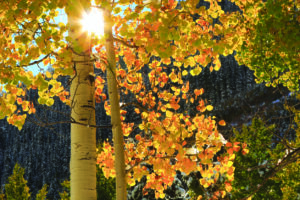Stir the Oatmeal Slowly
By Sarah Ann Noel
“…I wonder if this isn’t nature’s way of bringing us back to an organic simplicity – and in that quieter space, we find gratitude.”

This time of year, with Thanksgiving around the corner, there is a beautiful emphasis on gratitude. But this can be tricky for the average American citizen, making a mental and emotional shift away from stress toward simple thankfulness. We are saying our final goodbyes to warmth and light and leaves, and minutes seem to slip quickly in November—especially as the days are shortening—and these tightening constraints could trigger a rise in anxiety rather than the peace we are meant to find.
According to the National Alliance on Mental Illness, more than 19 percent of American adults have an anxiety disorder—that’s some 40 million individuals suffering some form of anxiety. Doctors at the Mayo Clinic aren’t certain of all the causes of anxiety, though it’s clear that certain individuals are more prone to such disorders if they have pre-existing medical conditions, have a family history of mental illnesses, or have suffered a traumatic or life-altering event. Of course, there are less rooted causes for anxiety as well, like anything that builds upon a person’s stress levels—and in this modern age, these external triggers are becoming more and more common, with a rise in social media use, political polarization and a constant bombardment of stimuli and information. What does this mean for our perception of the season? It stands to reason that making time for gratitude becomes just another “to-do,” and who has the time for something else to do?
However, in the study of time, some experts believe that time is a thinner concept than we give it credit. Marcelo Gleiser, author of “The Island of Knowledge: The Limits of Science and the Search for Meaning,” has reflected upon the concept of “presentness” as an illusion. In an excerpt of his book posted on NOVA, Gleiser compares our human perception of time—and the brain’s interpretation of it—to the speed of light, noting that even your reading of these very words is not presently happening for you, but is an understanding of something past. You have to account for the milliseconds it took your eyes and your brain to take in and understand the movement of light between the ink on the page and the correlating understanding of the actual language.
“The brain integrates the different sources of visual information, and since the differences in arrival time are much smaller than what your eyes can discern and your brain processes, you don’t see a difference,” he writes. “The ‘present’—the sum total of the sensorial input we say is happening ‘now’—is nothing but a convincing illusion.1”
“Present” is a notion out of our reach, likening time to water, something that can be experienced but not grasped. Still, presentness is a human virtue, something we have conceptualized to the point of general acceptance, and so the brain works in turn. “The present exists because our brain blurs reality,” says Gleiser, noting that for the brain “‘Now’ would be a much narrower experience, distinctive from the human ‘now.’
But what if we could stretch out the brain’s understanding of a present moment, marrying it more closely to our human meaning of the word? It would connect the emotional response to the physical one, and Mayo Clinic staff have found that “meditation, which is the practice of focused concentration, bringing yourself back to the moment over and over again, actually addresses stress.” In fact, this return to the moment—a focus on presentness—has been connected with relieving not only anxiety but also asthma, cancers, chronic pain, depression, heart disease, high blood pressure, IBS, sleep problems and tension headaches, according to the Mayo Clinic website.2
The thing is, meditation is rather un-American. We prefer to take control of moments, not admit that they’re hard to hold. We prefer to hustle, not scale back to the level required to really notice life. That is never more true than the holiday season, when nature is guiding us into something quiet and small and we instead light it up, pack in the activities and make ourselves dizzy with want. So, it’s easy to scoff at the hope that one could live in a meditative state, chalking the practice up to some mystic under a tree in the Far East.
When I wake to the darkness these mornings, I panic. But then I switch on the light above my bed illuminating the darkness, and I slowly come into understanding. It is a new day. I am warm under my sturdy shelter, cocooned in a cozy bed. With the first signs of magenta over the mountain peaks, I tiptoe to the bathroom, somehow primed to marvel at the flow of water from my sink. Upstairs, the sunrise is beautiful, and turning on the dimmest kitchen light, the one over the stove, is like my answer to the sky’s call—a little light goes a long way. My husband sparks the fire and as the wood crackles, the oatmeal begins to bubble on the stove. I slowly swirl a metal spoon around the pan, and it hums a morning song. I sprinkle in the cinnamon, savor the warm seasonal aroma, note the shuffle of our daughters’ footsteps upstairs, rallied by the scent of breakfast.
In the dark, cold mornings like these, the “sum total of the sensorial input” doesn’t feel like just an illusion. It’s more like perfect moments stretching out and on, like they could be eternal, like they are heaven. I realize, beginning the day in that way is a meditative practice—awareness, lending itself to gratitude. I find the shortening days cozy, almost like a narrowing focus. With more limited amounts of time, I should spend those minutes wisely, and I wonder if this isn’t nature’s way of bringing us back to an organic simplicity—and in that quieter space, we find gratitude.
As a kid I learned what Paul writes in 1 Thessalonians: the call to “pray without ceasing.” I took it to heart while simultaneously wondering how it could be physically possible. Perhaps in this achievement is the meditative lifestyle that leads to peace; and perhaps it is not a coincidence that the apostle who told us to always be praying also wrote in Colossians that we should be “overflowing with gratitude.” Perhaps the connection between prayerfulness and thankfulness exists not in the intention of the act but in how intentionally we live our lives.
José Hobday (1929–2009) was a Franciscan sister and Seneca elder during her life, blending her Christian faith with her mother’s Native American spirituality. Recently, Fr. Richard Rohr included some of her life’s wisdom in his daily newsletter. She wrote:
“My mother prayed as a Native American. That meant she saw living as praying and praying as living. She tried to pray her life. She expressed her prayer of gratitude, for example, in the way she did things. She told me many times, ‘When you stir oatmeal, stir it slowly so you don’t forget that oatmeal is a gift and that you don’t take it for granted.3’”
1 to.pbs.org/2Zz096p
2 mayocl.in/3nxGID6.
3 bit.ly/312evMR

